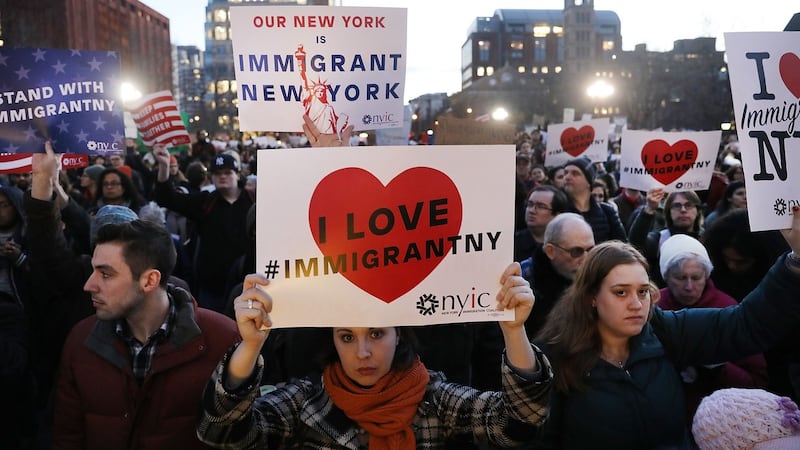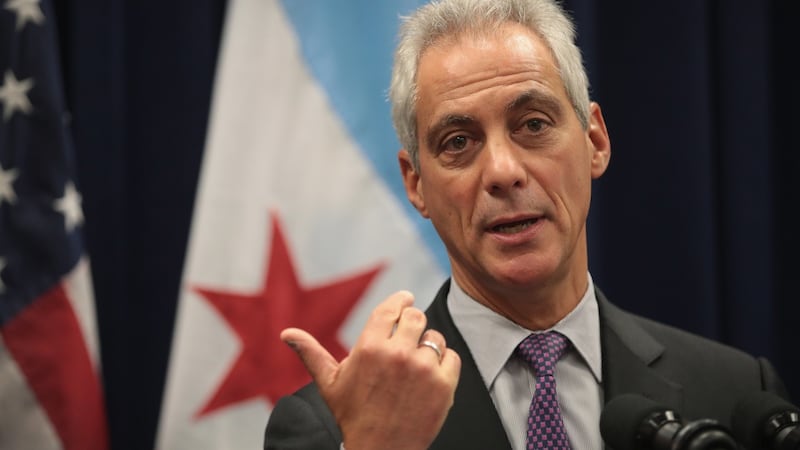The mayors of US cities large and small reacted with outrage after president Donald Trump signed an executive order on Wednesday saying he would halt funding to municipalities that did not co-operate with federal immigration officials.
The defiant officials – from New York, Los Angeles, Chicago and smaller cities, including New Haven, Connecticut; Syracuse, New York; and Austin, Texas – said they were prepared for a protracted fight.
“We’re going to defend all of our people regardless of where they come from, regardless of their immigration status,” mayor Bill de Blasio of New York said at a news conference, surrounded by other city officials.


In Chicago, mayor Rahm Emanuel declared: "I want to be clear: We're going to stay a sanctuary city. There is no stranger among us. Whether you're from Poland or Pakistan, whether you're from Ireland or India or Israel and whether you're from Mexico or Moldova, where my grandfather came from, you are welcome in Chicago as you pursue the American dream."
Trump’s order targeted what are known as sanctuary cities and counties, which generally do not comply with federal requests to detain unauthorised immigrants who have been arrested on charges unrelated to their immigration status and turn them over to federal authorities for possible deportation. Trump’s order said that jurisdictions that refuse to comply “are not eligible to receive Federal grants, except as deemed necessary for law enforcement purposes”.
But while Trump's position was broad and biting, it was unclear just how extensive any funding cuts could be. In the current fiscal year, New York City expects to get $8.8 billion (€8.2 billion) in federal funding for a variety of programmes, including education and transportation, to fill out its $84.8 billion annual budget. But the administration's ability to turn off the federal funds is limited, legal advisers to de Blasio said.
According to New York comptroller Scott Stringer, the federal grants that might be vulnerable include $9 million from the Department of Justice and $156 million from the Department of Homeland Security. But because that money is for counterterrorism efforts, it would seem unlikely that it would be cut.
"The rhetoric doesn't match the legal authority," said Peter Markowitz, director of the Immigration Justice Clinic at the Benjamin N Cardozo School of Law in New York. "In fact the president has very limited power to exercise any kind of significant defunding."
Continued fights
According to a 2012 Supreme Court decision, Markowitz said, Congress is not permitted to set conditions on spending to coerce states or localities to participate in a federal programme against their will. Any conditions, at a minimum, must be directly related to the punitive action.
In other words, Markowitz said: “You can’t say, ‘If you don’t use your police officers to go after unauthorised immigrants, you don’t get any money for your hospitals.’ They can’t impose conditions that are totally unrelated.”
According to the Immigrant Legal Resource Center, a national group, at least 39 cities and 364 counties nationwide count themselves as sanctuary jurisdictions, but they vary in how limited they are in restricting co-operation with immigration enforcement.
California has been one of the leaders in offering sanctuary, and reaction there was strong. An hour after the president signed the order, a group of California state senators said they planned to fight it in court, with help from Eric Holder Jr, the former US attorney general, whom the legislature has retained to take on what the senators said they expected would be continued fights with the Trump administration. They said Trump's order violated the 10th Amendment by forcing local governments to enforce federal statutes.
Mayor Sam Liccardo of San Jose, California, who counts his city among the ranks of sanctuaries without using the term, said that, on matters of public safety, "our police chief is the best person to decide how to use the scarce resources we have".
“It’s not simply an ideological decision,” he said. “Our police department, like most, doesn’t engage in federal tax laws, federal environmental laws or federal immigration laws.”
San Francisco featured prominently in the debate over sanctuary city policies after the killing of Kathryn Steinle, a resident of the city, in July 2015. Steinle was 32 years old when she was fatally shot by Juan Francisco Lopez-Sanchez, an immigrant from Mexico who was in the United States illegally. He had a long criminal record, a history of heroin abuse and had been deported to Mexico at least five times.
During the campaign Trump seized on Steinle's death as "yet another example of why we must secure our border immediately". A case brought by the Steinle family in federal court in May blames the San Francisco county sheriff at the time, Ross Mirkarimi, for issuing a memo that ordered his staff to cut off all communication with federal immigration authorities, according to court documents.
Lawyers argue that the memo contradicted federal law and "surpassed his authority". After Trump signed the order, San Francisco's mayor, Ed Lee, issued a statement in co-ordination with Liccardo of San Jose and the mayor of Oakland. "We will not give in to threats, or political grandstanding," Lee said. "Together, the Bay Area will stay true to our values of inclusiveness, compassion and equality, and united against any and all efforts to divide our residents, our cities, and our country."
In New York, de Blasio said the president’s order would threaten the relationship between the police and residents because unauthorised immigrants would be hesitant to co-operate with law enforcement.
But perhaps no official went as far as Boston's mayor, Marty Walsh. "To anyone who feels threatened today, or vulnerable, you are safe in Boston," Walsh said at a news conference. "We will do everything lawful in our powerful to protect you. If necessary, we will use City Hall itself to shelter and protect anyone who's targeted unjustly."
Walsh said he would allow people to effectively take up residence inside City Hall, evoking the “sanctuary church” movement, in which religious groups have offered shelter to unauthorised immigrants who fear deportation. “They can use my office; they can use any office in this building,” Walsh said. “They’ll be able to use this building as a safe space.”
New York Times









